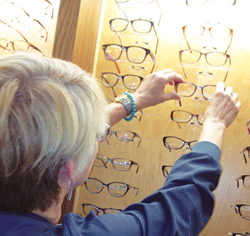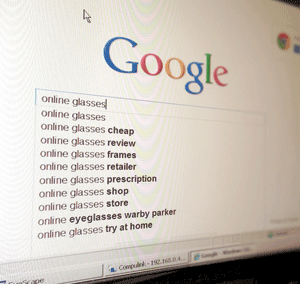You’re finishing your first patient exam of the day—a young professional in his late 20s who needed a change in his prescription to optimize visual function.

You discuss the lens options with him that will provide the best visual quality. An anti-reflective treatment along with a photochromic lens seems to best meet his lifestyle needs.
Additionally, he has expressed the desire for a second pair of glasses so that he has different styles to select from.
He sincerely thanks you for your thorough examination and for providing him with all of the information he needs… to order the glasses from an online retailer for the best price!
Mixed Messages
Although we may be disappointed—even upset—with our patient’s purchasing decision, we need to understand the rationale behind it. Consumers make purchasing decisions for all of their needs, including health care, based on perceived value.
Using information they’ve gathered on the products or services they want, they then determine the “worth” of those products or services. (See “Online Optical: Not as Close as You Think.”)
So, how do they decide which retailer to purchase from?
Ask yourself why so many people buy a Starbucks coffee that might cost three times as much as a coffee from another retailer, or much more than that if they make it at home.
Consumers expect to see differences in cost that proportionally match the perceived quality of the product. So, quality is just as important a factor as price in the consumer’s decision-making process.
But, to get back to our original dilemma: Why would our patient want to purchase his eyewear online?
|
|
Online Optical: Not as Close As You Think |
|
|
|
Online shopping for eyewear is still
uncommon—only about 2.9% of consumers who recently purchased eyeglasses
bought them over the Internet, according to the Vision Council’s 2012
VisionWatch Internet Influence Report (a survey of more than 9,000
American adults on their Internet eyewear purchasing activities).
That translates to approximately 1.8 to 2.0 million pairs of eyeglasses purchased online (out of 68.8 million total pairs sold during the 12-month period ending September 2012).
The VisionWatch
Internet Influence Report also found that online Rx eyeglass buyers
prefer to use websites operated by eyewear retailers, especially
retailers that have a presence only on the web (e.g.,
eyebuydirect.com,
framesdirect.com,
coastal.com).
Indeed,
most consumers avoid the Internet for spectacle shopping because they
enjoy buying eyewear in person and cannot physically try on eyewear
online. “For American adults who recently purchased Rx eyeglasses, the
trusted relationship they have with their eye care professional or
retailer was another factor that impeded their use of the Internet when
recently purchasing eyeglasses,” the report found.
In
short, buying glasses online hasn’t swept the nation yet. But by no
means should you remain complacent. In fact, the number of eyewear
buyers who “will possibly or probably” use the Internet to buy eyewear
in the future continues to increase—some 26.1% of recent eyewear buyers
indicate they will likely use the Internet to directly purchase eyewear
in the future.
And online consumers are happy about it. More than 90% of those who bought glasses online were satisfied––40.2% rated their online purchase experience as “good,” while 51.8% rated it as “excellent.” |
|
Creating Commodities
Let’s try to understand the factors that may be influencing this patient’s decision. Via direct-to-consumer advertising, online glasses retailers are constantly sending our patients two messages:
- Their glasses are the same as what you get at traditional brick-and-mortar locations.
- Their products cost less than traditional brick-and-mortar retailers.
Online retailers are doing their best to commoditize eyewear. Commodities are essentially products that, in a consumer’s mind, have few to no differences among them. Ultimately, price is the only thing that differentiates one commodity from another.
So, if the patient relies on the information from the online retailer, price is then the only factor in purchasing a pair of eyeglasses. As we know, this is far from the truth—and it’s based on misinformation.
Make It Personal
We know there are variations in the quality of the frame materials, lens designs and services that we provide those who purchase eyewear from our office. But how many of our patients know about these differences?
For most of our patients, glasses have become something of a commodity because large online retailers have controlled the conversation about eyeglasses.


Which is better? Despite the Internet’s convenience, most consumers still prefer to shop for eyeglasses in person. It’s up to you to keep providing that personal touch.
Our young professional described in the original example believes he can get the same glasses from an online retailer at a lower price—in his mind, it’s a no-brainer.
So, how do we create an awareness of the differences that exist in products? How do we establish and communicate the value of the eyewear that we retail?
We need to offer them something online retailers can’t—a personal experience. The patient needs to understand that they can get much more from the eye doctor’s office than measurements.
An accurate prescription and PD measurement are just the beginning. (See “To PD or Not PD?” below.)
In the optical, patients not only have a multitude of frames laid out before them, they also have experts at their disposal to provide guidance, walk them through the process and explain the various options.
All patients have expectations walking into our practices, and we want their experiences to be positive. To maximize that experience, we have to do our best to exceed the patient’s expectations. If we exceed expectations, we’ve created a positive experience. On the other hand, if we fail to meet their expectations, we’ve created a negative experience.
So, ensuring a positive experience by making certain we’re conscious of the perceptions we’re creating ultimately helps de-commoditize our services and products, and adds value as well.
|
|
To PD or Not PD? |
|
|
|
Lately, a sensitive
issue among eye care practitioners is whether to release the pupillary
distance as part of the patient’s spectacle prescription.
Some
doctors charge a fee for giving a patient a PD, but then offer that as a
credit if the patient purchases glasses from the practice. Others
simply give the PD in good faith and with some education on the benefits
of the eyewear that they dispense.
We find merit to both of these
options and, depending on where you work, you must decide for yourself
on what is best for your patient and your practice.
|
|
Value-building Strategies
How can we do this? Here are some strategies that work:
• Educate yourself and your staff about the latest lens options. Proper patient education starts with superior office education. Be sure to include all the key players who work with patients in the optical—the prescribing optometrist, the opticians and the paraoptometrics.
When everyone is up to date on the newest ophthalmic lenses and lens options, they have the product knowledge necessary to offer the options that best suit the patient.
The ability to explain the difference between a lens worn for a specific job or sport vs. those worn on a daily basis builds the patient’s confidence in the services we’re providing and lets them know we’re aware of their individual needs.
• Provide service with a smile and communicate with conviction. Phone etiquette is critical because it shapes initial patient perceptions. When anyone in the office answers the phone, it is important to “speak with a smile” and express a positive attitude for patients or potential patients.
You should also apply this basic but fundamental principle to communication when the patient is in the office.
Our patients receive much of their information about products through our recommendations, so it’s important to speak with honesty and conviction when we make suggestions to the patient in order to build confidence and trust.
• Establish your role in the process. Let patients know that you’re still concerned about their care even after they leave your chair.
After you complete the patient’s exam, you might say something like: “We measured your prescription to a high level of precision today, and these measurements will help us ensure that your new eyeglasses provide you with the best vision possible.”
This conveys that there is a direct relationship between the optometrist and the optical, and that you always work together to deliver the best visual outcome for them.
• Ensure a smooth transfer of care. When you’re finished with the exam, deliberately transfer the patient’s care to the optician or paraoptometric who will guide them through the rest of the process.
Introduce the patient to the optician and provide a brief verbal summary of the exam along with eyewear recommendations.
This further shows the high level of expertise, communication and organization in your practice, and ensures that everyone is on the same page in the process.
• Offer high-end frames as well as options for the price-conscious shopper. Regardless of the price tag, the frames we display need to be fashionable, comfortable and dependable.
It is always a good idea to provide a few higher-end frames to show the patients there is some exclusivity in our practice. But it’s also useful to have a few lines that appeal to the bargain shopper.
Some patients will remark that they want “cheap frames” when they’re actually looking for value frames—it’s important to educate the patient about the difference.
A cheap frame describes one that is inexpensive and of poor quality. A “value frame” is one that may be at a lower price point but has a certain level of quality that you’re comfortable working with and dispensing. This distinction is a significant one, and one you should take into consideration when selecting a value line.
Discuss the features that separate these glasses from the others in your office to help your patients understand the differences between lens and frame qualities as well as price.
• Give great follow-up. One area where online vendors fall short, and we shine, is great follow-up service. Be sure to let patients know that you welcome them to return for any problem or difficulty with the products you sell.
Can an online vendor make a quick adjustment to the frames while the patient waits? Not likely. Right from the start, educate patients about this important distinction between your friendly optical and some faceless website.
• Use social media as another optical display. Social media provides a great venue for consumers to see your practice. It can provide an active means of staying in touch with your patients and affords another avenue to deliver information about your eyewear via posts, photos or even special events, such as frame shows.
Ultimately, the more effectively you provide an exceptional experience, the better your chances are to compete with online vendors.
Dr. Brujic is a partner of Premier Vision Group in northwest Ohio. Dr. Kading owns Specialty Eyecare Group, a Seattle-based practice with multiple locations. Ms. Hagemeyer is a certified optician at Premier Vision Group.

